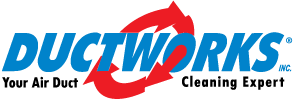100 FIVE STAR AIR DUCT CLEANING REVIEWS
 Denver, CO.— Air Duct Cleaning Industry Leader, Ductworks, Inc., achieves “100 Five Star” Air Duct Cleaning Reviews from the Customer Lobby in less than 6 months.
Denver, CO.— Air Duct Cleaning Industry Leader, Ductworks, Inc., achieves “100 Five Star” Air Duct Cleaning Reviews from the Customer Lobby in less than 6 months.
Customer Lobby is where consumers share their ratings and reviews on the local companies they hire. Company ratings are based strictly on feedback from customers of Ductworks, Inc. The Customer Lobby Five Star Grading Systems represents the level of service, level of recommendation, and total experience that Ductworks, Inc., has provided its customers.
“We are extremely proud of the reviews that we have received though Customer Lobby, the reviews are a testimony to our technician’s commitment to excellent customer service.” said Edward Frisk, Vice President of Ductworks, Inc. “For over 20 years, Ductworks, Inc. has been dedicated to offering quality air duct cleaning and world-class customer service. Customer Lobby serves as a strong resource in helping consumers better understand our overall commitment to an unparalleled air duct service.”
To view Ductworks, Inc. reviews on Customer Lobby, visit Ductworks, Inc. Customer Lobby review page
# # #
About Ductworks, Inc. – Your Air Duct Cleaning Expert
Ductworks, Inc. “Your Air Duct Cleaning Expert” is a Denver-based air duct cleaning company founded in 1990 to improve indoor air quality for homes and businesses. Their patented system of scraping and vacuuming is the most effective process for air duct cleaning. They have more technicians certified by the NADCA than any company in Colorado and provide customers with before and after photos to insure top quality performance. For more information, contact us at 303-425-0985 or ductworks.com
About Customer Lobby
Customer Lobby is the leading customer reviews solution provider focused on service businesses. Customer Lobby’s quality guarantees and dispute resolution services are unique and critical features for the 200 industries it serves. Customer Lobby’s solution enables businesses to get, manage and publish customer reviews. For more information, contact us at 866-718-9549 or www.customerlobby.com.


 Ensuring good indoor air quality is easy once you have an understanding of the components that effect your homes environment. Using the steps below, perform a quick checklist to improve your indoor quality.
Ensuring good indoor air quality is easy once you have an understanding of the components that effect your homes environment. Using the steps below, perform a quick checklist to improve your indoor quality.